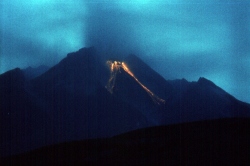


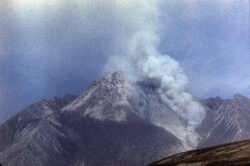
The first months of 1986 were relatively quiescent except for fumarolic
activity, duringwhich a steam and gas column rose to a height of 0.5 to
2.5 km above the volcano, depending on the weather. By the end of March
debris avalanches occurred as a result of a renewed extrusive process.
As the extrusive process developed further, a dome-shaped bulge appeared
on the surface of the near-summit area of the lava flow; it was ~50 m high
and ~150 m across at the base. Its growth was accompanied by gradually
intensifying rockfalls from its surface.
By early June almost no lava flow rocks remained on the surface of
the forced-out block. During that time snow often fell and covered the
slopes of the volcano; it melted immediately on the surface of the extruding
block, which indicated that the material composing it was hot. The debris
avalanches of that period were relatively scarce and slow, and the debris
accumulated at the base of the growing extrusion.
In mid-June the extrusive process grew more powerful, debris avalanches
became more frequent, and the debris, accumulating at the base, gradually
covered the previous lava flow. By June 20 the debris of some avalanches
traveled as far as the lower end of the trench, and the growing extrusion
rose to a hight of ~100 m and was ~200 m across at the base.
 |
 |
 |
 |
During the two days that followed the extrusive form of the eruption
changed gradually to an effusive phase. The upheaval of the block was totally
reverted by its destruction as a result of debris avalanches, and its height
remained almost the same or was even decreasing, as the new, increasingly
plastic material began to spread. By June 22 only the southern marginal
portion of the extrusion rose as a small obelisk, the rest had been transformed
to a lava bulge.
Simultaneously, a new type of avalanches appeared: they were accompanied
by intensely curling ash clouds of the cauliflower type. The formation
of such avalanches was related to the effect of autoexplosivity that usually
appears during the collapse of the large volumes of a gas-saturated hot
material. On the night of June 23 a bright-red glow was seen at the front
of the lava bulge; on June 24 dull-red fragments were observed in the avalanches
in the day time. The ash that rose during the frequent powerful collapses
trailed southward for a distance of 30-40 km along the eastern slopes of
Mts. Ziminy, where small ash falls were recorded, even though no ash was
ejected from the vent.
By that time the remnants of the extrusion were totally demolished
and covered by a viscous lava flow ~ 120 m long that was moving at a speed
of ~5 m/h. On the night of June 24 there occurred an explosive-effusive
climax of that period of activity: ash was ejected, two pyroclastic flows
were formed, and the lava flow moved at a greater speed. Unfortunately,
it was too cloudy to observe the eruption. At the June 26 daybreak the
glow of the lava flow front could be seen where the clouds cleared; the
length of the flow attained 400-450 m. Its speed was hence estimated for
that period to be ~ 10 m/h. Based on the extent to which the lava filled
the trench, the total thickness of the lava flow and the underlying avalanche
deposits was estimated at 40-50 m, whereas the apparent thickness of the
lava flow was 10-20 m at its front.
The eruptive activity declined rapidly after the climax. Having reached
a length of 500-550 m by June 29, the lava flow stopped. Avalanches and
associated glow became less frequent, were much weaker, and virtually ceased
by July 1. A repose period set in with a moderate fumarolic activity.
A new active period began, like the previous one, with a gradually augmenting
destructive-extrusive process. On October 17-18 I inspected the lava flow
that had descended along the trench during the spring and summer eruptive
period. I did not find any changes on its surface, even on its near-summit
segment. On November 7, however, I saw a dome-shaped bulge on its near-summit
portion; it was 50 m high and ~100 m across at the base. This deformation
dome was cut by a NW-trending vertical fissure. So the first impacts of
the deformation-extrusion process of that period can be attributed to late
October - early November.
 |
The further development of the process was similar to the pre-climax
phase of the previous active period. By November 25 the dome-shaped bulge
on the surface of the near-summit segment of the lava flow was as high
as 80 m with a ~ 120-meter diameter at the base. The fissure cutting the
bulge had grown in size. In early December avalanches of lithic debris
began to slide suddenly from the surface of the growing extrusion. By December
8 the upheaving block was totally free of the lava flow remains, and on
the night from December 9 to 10 the first glow of the debris avalanches
was recorded.
The next phase was the transformation of the doming and simultaneously
crumbling extrusion to a lava bulge. Avalanches grew more frequent, their
deposits thicker, and their glow brighter in the night time. By December
14 the lava flow of the spring-summer period of activity was wholly buried
under the debris. What remained of the upheaving block was its SE portion
that stood as an obelisk ~100 m high and 80 m across. The larger area of
the former block was occupied by a lava bulge ~60 m high and 150-200 m
across.
On December 15 and 16 I could see fumarolic activity and small
debris avalanches, accompanied by the ruby-red glow of the falling rock
fragments in the darkening twilight. A white steam and gas column rose
periodically to a height of ~1200 m above the volcano; it was occasionally
tinted gray by the ash rising as the avalanches crushed down.
 |
On December 16 a steam-gas column with some ash of an avalanche origin
rose to a maximum height of 1500 m. Along with frequent collapses, two
powerful avalanches were observed (see the picture above). They were accompanied
by characteristic ash clouds of the cauliflower type. Toward the night
the glow became almost continuous. Not only were the falling rock fragments
of bright color but also, for a few seconds, the places where they hit
the ground that consisted of the hot, previously fallen debris. Some of
the falling or rolling down fragments amounted to 10 m across.
A distinctive feature of these and some of the other avalanches that
took place in the evening of December 16 and at night of December 17 was
their peculiar glow. In contrast to the usual rock avalanches, the whole
cauliflower ash cloud was glowing purple. The glow of the fragments could
be seen when the cloud ceased to glow or dispersed. The generation of a
large amount of incandescent and hence glowing ash occurred simultaneously
with the collapse. This indicates that the effect of autoexplosivity occurred
during the collapses of the large volumes of high-temperature gas-rich
material.
On the night of December 17 all the remnants of the extrusion had been
completely destroyed. The slow sliding of the lava bulge material had produced
a viscous lava flow which was 200-220 m long by that time. The main source
of the avalanches was its frontal portion. The continuous glow of the fractures
at the front of the lava flow permitted me to estimate its thickness at
20-25 m.
 |
In the morning the volcano was covered by low clouds and it was snowing.
The weather changed gradually for the belter only toward the midday At
12 h 20 min an ash column was seen between the clouds to rise as high as
1700-2000 m above the summit. A dark bell of pyroclastic flow deposits
was clearly seen against the snow at the base of the volcano. The flow
traveled ~4.5 km from the cone.
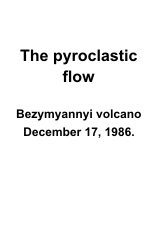 |
By 12 h 40 min it was possible to observe the Novyi Dome; the clouds
that had covered it dispersed. It could be seen that the source of the
ash had been the cauliflower clouds that accompanied almost continuous
collapses. At 12 h 47 min the avalanching increased rapidly and a pyroclastic
flow was formed. Some of the numerical characteristics of that process
given below were obtained with the help of a moviegram, a photorecord of
its development with a 5-second interval. Photographs were made from the
Nizhniy Camp 8 km from the volcano. A sample record (30-second interval)
is shown above.
The photographic recording of the pyroclastic flow began when its front
was at a distance of 2.8 km from the vent. The speed of its movement at
that instant and during the next 15 seconds was ~45 m/s (160 km/h). Afterward
the speed of the flow dropped rapidly, and it stopped at a distance of
4 km from the vent 45 s after the beginning of the photography. As soon
as the front of the flow stopped, its ash cloud started to retreat up the
slope at a speed of ~10 m/s; the material deposited at the front of the
flow continued to emit ash-loaded gases. The clouds of the latter were
drifted upward along the surface of the flow by the wind which had a speed
of not less than 20 m/h near the flow but was not felt at the camp. The
local character of the wind indicated that the air above the flow had been
heated and risen upward decreasing abruptly the atmospheric pressure. It
should be noted that such a hurricane wind was often a rescue for the observers
who accidentally happened to be near a pyroclastic flow front. Examples
are the 1902 eruption of Mont Pelee and the 1980 eruption of Mount St.
Helens.
In spite of the fact that the frontal portion of the flow had stopped,
pyroclastic material continued to move down the slope and was deposited
at a distance of 3-3.5 km from the vent. This was evident from the behavior
of the attending ash-loaded cloud: it followed the downward movement of
the pyroclastic material and rushed up the slope with a speed of 10-12
m/h where the pyroclastics accumulated in large masses. Because of some
inertia, the ash cloud rose at an angle of 70 degrees to the horizon in
the direction away from the vent. The ash cloud rising above the summit
had the same speed. Its main source was the site where the juvenile material
that rolled down the Novyi Dome hit the caldera slope. This ash cloud attained
a maximum height of 9 km 15 minutes after the origin of the pyroclastic
flow.
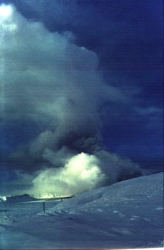 |
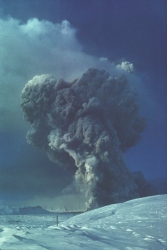 |
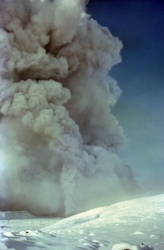 |
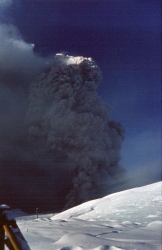 |
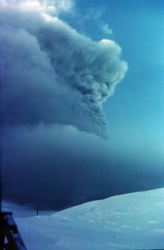 |
The climax of the pyroclastic eruption was recorded at 12 h 49 min.
At that time the continuous-spasmodic tremor that accompanied the process
was recorded to have a maximum amplitude (5.8 micron). The pyroclastic
flow eruption lasted ~0.25 h, as measured from the sudden intensification
of avalanches to the onset of the ash cloud dispersion.
At 13 h a low-frequency noise was heard; it lasted 15 minutes. At 13
h 08 min an ash fall began on Mts. Ziminy (10 km south of the volcano).
Two more pyroclastic flows were formed from 13 h 18 min to 13 h 35 min.
The dynamics of their development was similar to that of the flow described
above except that they were less powerful, had a shorter length (3.5 and
3.0 km, respectively), and the tremor recorded at Apakhonchich Station
was lower (5.0 and 3.5 micron, respectively).
At 13 h 50 min low-frequency noise was heard again and grew louder.
By 14 h 20 min a vertical eruptive column was seen through a dispersing
ash curtain to rise to a height of ~7 km above the summit. A vigorous continuous
gas and ash ejection occurred from a crater ~200 across (as indicated by
the size of the column base) that developed in the trench area from which
the extrusive blocks had been forced out previously. Simulta-neously, large
volumes of lava were seen through the ash curtain to move in the trench;
its movement was accompanied by collapses and a dull purple glow (seen
even in daylight). The process of the simultaneous and continuous eruption
of the ash column and lava flow was accompanied by surface volcanic earthquakes.
The largest of them occurred at 14 h 07 min (2.1 micron), at 14 h 19 min
(4.6 micron), and at 14 h 27 min (2.5 micron).
By 15 h 35 min the noise subsided slowly and recommenced at 15 h 50
min. By that time, according to observations at Vodopadnyi Station, located
at the SW slope of Ploskiy Tolbachik Volcano, the ash cloud stretched from
Bezymyannyi southward over a distance of ~60 km. Ash began to fall at the
Nizhniy Camp from which the observations were performed. By 16 h 25 min
the noise subsided, and the ash cloud showed some clearances.
At 17 h 05 min it was possible to continue observations. By that time
the explosive activity had ceased. A white steam and gas column rose to
a height of 1700-2000 m at which it was seen to be drifted in a southeastern
direction. The pyroclastic flow deposits were steaming and phreatic explosions
were heard. At 17 h 42 min short noise and rattle were heard, and glow
was seen in the darkening twilight in the lower end of the trench. These
phenomena were obviously caused by the collapses of the frontal portion
of the lava flow that might be produced by its small-scale movements.
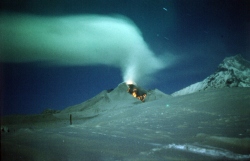 |
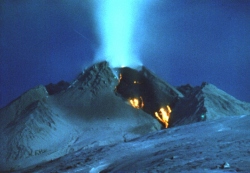 |
By 18 h 25 min the remnants of the ash haze had dispersed completely.
The base of the steam/gas column rising above the near-summit end of the
trench was seen to be illuminated to a height of ~100 m and ~200 m across.
Glow was seen in the fragments of some avalanches on the surface and at
the front of the lava flow that had traveled 600-650 m by that time and
occupied nearly the entire trench area. The volcano was in that state till
2 h 30 min when it was covered by low clouds. By that time the height of
the column decreased to 1000 m, and its base was no more illuminated.
On December 18 the column was 700 m high in the daytime, 500 m in the
afternoon, and 300 m in the evening, indicating that the thermal power
of the process decreased gradually. Occasional avalanches were observed
at the lava flow front till January 5, 1987; glow was seen in some of them
in the nighttime. Afterward, the volcano was in the state of moderate fumarolic
activity and a slow extrusive eruption.
The glow of collapse avalanche in June of 1987 - the typical external manifestation of a long extrusive eruption
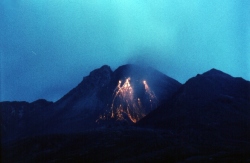 |
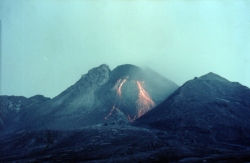 |
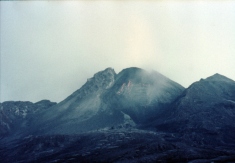 |
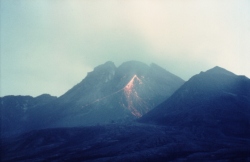 |
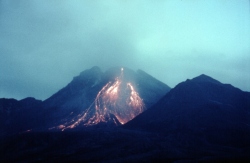 |
 |
Although the external manifestations of volcanic activity attenuated
and could not be seen by the unaided eye, the examination of the photographs
revealed that the eruptive process had not ceased. By December 26 deformations
appeared in the near-summit end of the trench in the form of a cone ~30
m high and 60-80 m across at the base. By January 7, 1987, the deformation
process spread over an area of ~200 m: nearly the whole of the near-summit
portion of the lava flow had been upheaved to a hight of 40-60 m.
During the later half of January, outwardly, the volcano exhibited
merely a moderate fumarolic activity, common for its repose periods. In
spite of the continuously developing upheaval, there were no rock avalanches
that had previously accompanied it: the December lava flow was stable and
its near-summit portion that was undergoing deformation had not begun to
crumble. By early February the lava that had covered the upheaving block
began to crack and fall down from its surface. By the end of February no
lava material remained, and the block had the form of a truncated cone
~100 m high and ~250 m across at the base and ~150 m at the top.
As the block advanced further, the process of its destruction intensified.
Whereas in early March the fragments of the lava avalanches had accumulated
at its base, by the end of March the mantle of the clastic material covered
the larger area of the December lava flow. By that time the advancing and
severely crumbling block occupied an area ~300 m across and had a critical
height of -120 m.
In April the eruption process changed gradually from an extrusive to
an effusive mode, and the actively upheaving block transformed to a lava
bulge. On the night of April 15, for the first time since January 15, the
incandescence of the fragments avalanching from its surface was recorded.
Avalanches occurred as frequently as ~20 per hour, no signs of autoexplosivity
were recorded, and only the largest of them exhibited incandescence. Occasionally,
some ash of collapse origin fell in the vicinity of the volcano, but the
larger amount of ash was entrapped in the steam and gas column and was
carried far away from the cone. The SE part of the trench was gradually
filled with collapse-produced clastic material. By the end of April some
rock avalanches extended beyond the trench and were deposited on the SE
slope of the dome.
Toward April 20 the slowly extruded viscous lava began to slide down,
and by April 25 its front had moved 80-100 m down the slope. The average
speed of its movement was hence ~1 m/h. In May and June the lava flow continued
to advance mainly along the NW margin of the trench. By June 14 it had
moved -400 m. Its frontal portion crumbled continuously and fell down in
the form of avalanches. The resulting deposits accumulated to fill the
trench that had been produced by explosions and collapses of the 1985 eruption.
By early July the whole trench was virtually filled by a volcanic breccia.
The material of the collapse avalanches began to spread over the SE slope
of the stable Novyi Dome. The lava flow moved predominantly in the same
direction. This activity continued till the autumn of 1987. Although there
was no explosive climax during the 1987 period of the eruption, the amount
of juvenile material was larger than the volumes erupted during the active
periods of 1986; it was ~9 million m3, the average rate of discharge being
~50 000 m3/day.
Evolution of active block in the 1986-1987 eruptions
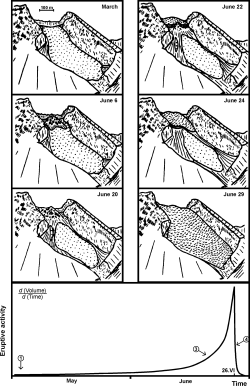 |
 |
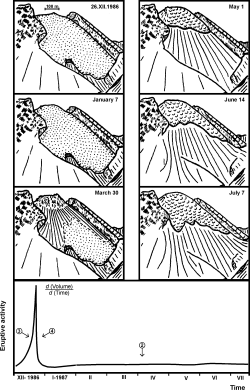 |
|
|
December of 1986. |
in 1987. |